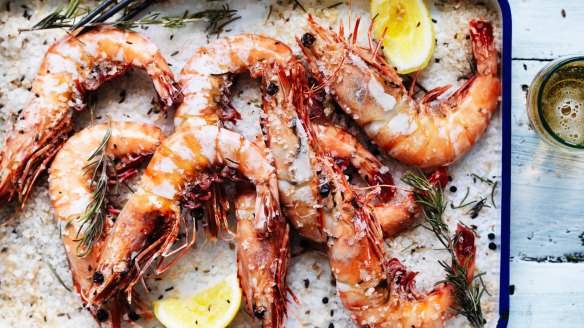What's the best way of preparing prawns?

What's the best way of preparing prawns? S. Jenkins
The best way of preparing prawns (if you can't net them yourself) is to buy frozen green Australian prawns and thaw them in the fridge over 24 to 48 hours. You can barbecue them on the grill for a few minutes each side until they change colour. When we were on holiday as youngsters, we would net prawns and quickly boil them in seawater. Goodness, they were sweet. If you boil prawns in freshwater, osmosis will draw out the salty juices from inside. Take a very large pot and fill it almost to the top with water. You can make your water salty by adding 15-30g of salt per litre of water, depending on your taste. Bring the water to the boil and carefully add your prawns, no more than a kilo at a time. Cook for two or so minutes or until they change colour, and remove with a slotted spoon. Put immediately into a salted ice bath to stop the cooking process. Drain. Peeling prawns and enjoying them with an ice-cold beer is an Australian tradition. Make sure you have a finger bowl or plenty of towels to clean your hands. Consider adding the fresh prawns and mayonnaise to a sandwich made with buttered white bread.
Is it doughnut or donut? R. Caldwell
Fermented dough balls fried in oil and cloaked in sugar or honey and spices are nothing new. The Greeks have their loukoumades, beautiful golden globes of fermented dough fried in olive oil and slathered with honey and cinnamon. These, in turn, were based on the Arabic dish luqmat al-qadi, which are basically the same but with the addition of rosewater. The Dutch have their oliebollen, which are pretty similar. They took their deep-fried fermented dough balls to the Americas, where they were renamed dough nuts, the word "nut" being used to described the walnut shape. The words were combined into "doughnut" by about 1800, and by 1900 the shortened version "donut" appeared in print. The hole was developed in the mid-1800s in an attempt to avoid uncooked insides. While the world is mad about sweet doughnuts, there is a much underrated fried fermented dough ball from Italy called zeppole. Yes, they dust them with powdered sugar, but also make a savoury version stuffed with an anchovy and sprinkled with salt.
Letters
A few weeks back, we were discussing using whey from strained yoghurt. J. Thompson uses the whey in bread dough instead of water, claiming it gives her bread "a lightness and a more intense sour flavour as well as a lovely dark crust". We were also discussing how silver cutlery can taint food. C. Davis writes "sterling silver, when properly maintained in clean condition and polished, does not taint food". J. Picot added to the conversation, writing in to say: "It's commonly assumed that stainless steel is so-called because it doesn't rust. But the first application of the new-fangled steel (basically carbon steel with at least 12 per cent chromium added) was for domestic cutlery because up until then ordinary carbon steel left unsightly brown stains on fine white table linen. Stainless steel didn't, so was called stainless because it didn't stain the linen, not because the metal itself didn't stain."
Send your vexing culinary conundrums to brainfood@richardcornish.com.au or tweet to @foodcornish
Appears in these collections
- More:
- Food
- Brain food
